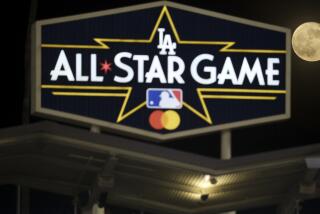More Than a Number on a Jersey : American Legion Serves Summer Baseball Well
- Share via
On most American Legion baseball uniforms is a number. Not the player’s number, but a post number.
It is that little number on a sleeve or jersey pocket that designates which American Legion post is sponsoring the team.
Some players can tell you the number without hesitation, but most cannot tell you anything about the 69-year-old organization behind it.
The American Legion is the world’s largest war veterans’ group with 2.8 million members in 15,000 posts. It has sponsored summer youth baseball for 63 years, making it the benefactor of the nation’s longest-running amateur baseball program. And although the organization is becoming less active with age, Legion baseball is on the rise, particularly in the San Fernando Valley.
“The posts aren’t in good financial shape. They are dying out while the demand for baseball teams is growing,” said Mel Swerdling, commissioner of District 20, which comprises 22 Legion teams in the Valley area.
Members, of course, are aging and because 15 years have passed since the last war, the Legion isn’t gaining many new members. Some Legion posts are still the places to be on Saturday nights while others are fading away; the advance of time hasn’t stopped Legion ballplayers, from swinging.
With about 3,900 teams in all 50 states, Puerto Rico and Canada, the Legion has experienced an increase of 600 squads over the past four years, according to James Quinlan, the Legion’s national baseball program coordinator. Quinlan notes that about 55% of the current major leaguers are former Legion players, 64% if you exclude foreign-born players.
There are 31 districts and 188 teams in California. In addition to the 22 teams in District 20, six teams from District 16 are located in the Valley area. District champions meet in one of six area tournaments in early August, and the winners advance to a state tournament in August in Yountville, Calif. The state champion and runner-up advance to one of eight regional tournaments and, from there, to the American Legion World Series, which will be held in September in Middletown, Conn.
The program today pervades large cities and small towns. Pennsylvania (600 teams) and Minnesota (400) have the strongest programs.
But Legion baseball is not the same around the country. In some areas, organizations such as Big League and Connie Mack compete for the top players with the Legion. But Legion is winning the competition in the Valley, several coaches say.
“The difference is that usually American Legion is the best brand of baseball,” said Frank DesEnfants, coach of the Reseda American Legion team. “They are playing as a unit, with the guys they played with in high school.”
To join a Legion league, a team must be affiliated with a high school. That is, the players must attend the high school or have graduated from the high school the Legion team represents, said Harold Hall, the state Legion commissioner. A team can draw from more than one school, but the schools’ combined enrollment cannot be more than 3,600 for the 10th through 12th grades.
In some states, (Arizona, Oregon, Ohio, Pennsylvania and Minnesota, among others) all Legion teams are sponsored by posts. Yet sponsorship is not necessary to field a team. In fact, only half of the 28 Valley-area teams are sponsored, which is about the percentage nationwide.
The Yakima, Wash., Legion team, for example, has not been sponsored by a post in 20 years. Instead, the community raises $30,000 a year to meet expenses for the team’s ambitious schedule. The Yakima team travels throughout the Northwest during the summer and has won one American Legion World Series in four trips during the past two decades.
Similarly, one of the most successful posts in the nation is Post 8 in Las Vegas, which twice has played host to the Western regional. The post sponsors only one team, however, and the other 11 Las Vegas clubs must find their own sponsors.
A post typically contributes from $500 to $1,500 a season, which is just a portion of a team’s operating costs. Swerdling estimates expenses--which include a district entry fee of $1,056, insurance, umpires and trophies--run between $2,000 and $2,500.
A post can sponsor more than one club. The Anaheim post, for example, partially funds four teams.
Beyond supplying cash, the post also supplies a general manager, who is usually a member of the American Legion. A high school coach or some other individual normally handles the field duties. At the end of the season, the post often holds a banquet for the team and issues awards.


